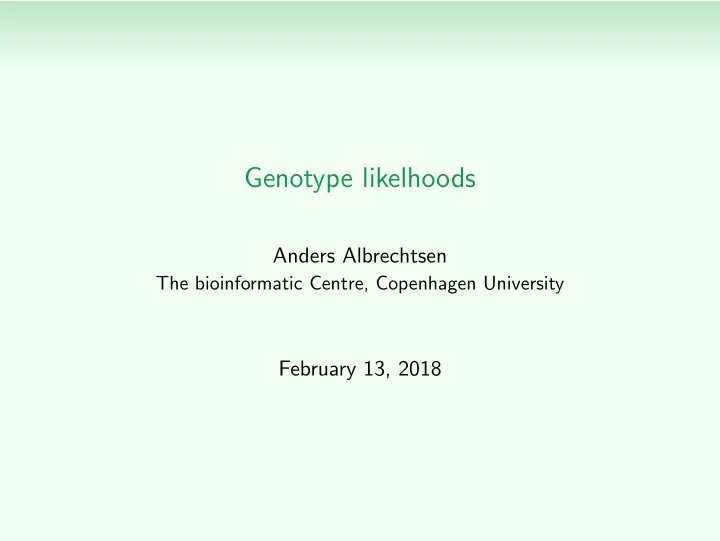

Genotype likelhoods Anders Albrechtsen The bioinformatic Centre, Copenhagen University February 13, 2018
Mapped reads My definitions (The literature is not consistent) Depth The number of reads that maps to a position Counts The number of different alleles mapped to a position Coverage The fraction of the genome (region) with data
why don’t we have genotypes? This is not like Sanger sequencing Sanger Both alleles are amplified and sequenced at the same time. NGS Each allele is sequenced separately and the allele are sampled with replacement
why don’t we have genotypes? Question? Assuming an error rate of 1% • Is the individual heterozygous C/T?
What do we expect P(2 or less minor bases | heterozygous) = 0.065 assuming heterozygous 0.20 0.15 probability 0.10 0.05 0.00 0 1 2 3 4 5 6 7 8 9 10 11 Number of Ts
What do we expect P(2 or more errors | homozygous) = 0.00015 assuming homozygous 0.8 0.6 probability 0.4 0.2 0.0 0 1 2 3 4 5 6 7 8 9 10 11 Number of Errors
why don’t we have genotypes? Question? Assuming an error rate of 1% • Is the individual heterozygous C/T? • P(2 or more errors | homozygous) = 0.00015 • P(2 or less minor bases | heterozygous) = 0.065
why don’t we have genotypes? Question? Assuming an error rate of 1% • Is the individual heterozygous C/T? • P(2 or more errors | homozygous) = 0.00015 • P(2 or less minor bases | heterozygous) = 0.065 • on average there is about 1 heterozygous site per 1000 bases
Genotype likelihoods Summarise the data in 10 genotype likelihoods A C G T bases (b): A 1 2 3 4 TCCTTTTTTTT C 5 6 7 quality scores (Q): G 8 9 GHSSBBTTTTG T 10 The likelihood P ( Data | G = { A 1 , A 2 } ) ∝ P ( X | G = { A 1 , A 2 } ) = P ( X | G ) where A ∈ { A , C , G , T }
Estimating genotype likelihoods GATK (McKenna et al. 2010) n n � 1 2 P ( b i | A 1 ) + 1 � � � P ( X | G ) ∝ P ( b i | A 1 , A 2 ) = 2 P ( b i | A 2 ) i =0 i =0 � b � = A ǫ where P ( b | A ) = 3 b = A , 1 − ǫ where G = { A 1 , A 2 } , b is the observed base and ǫ is the probability of error from the quality score.
Example of genotype likelihood calculations b Qasci Qscore ǫ p ( b i | T ) p ( b i | C ) p ( b i | G / A ) T G 38 0.00016 1 - 0.00016 5.3e-05 5.3e-05 C H 39 0.00013 4.2e-05 1 - 0.00013 4.2e-05 C S 50 1e-05 3.3e-06 1 - 1e-05 3.3e-06 T S 50 1e-05 1 - 1e-05 3.3e-06 3.3e-06 T B 33 5e-04 1 - 5e-04 0.00017 0.00017 T B 33 5e-04 1 - 5e-04 0.00017 0.00017 T T 51 7.9e-06 1 - 7.9e-06 2.6e-06 2.6e-06 T T 51 7.9e-06 1 - 7.9e-06 2.6e-06 2.6e-06 T T 51 7.9e-06 1 - 7.9e-06 2.6e-06 2.6e-06 T T 51 7.9e-06 1 - 7.9e-06 2.6e-06 2.6e-06 T G 38 0.00016 1 - 0.00016 5.3e-05 5.3e-05 n n � 1 2 P ( b i | T ) + 1 � � � P ( Data | G = TC ) ∝ P ( b i | T , C ) = 2 P ( b i | C ) i =0 i =0
Genotype likelihoods Other methods samtools/H. Li et al. 2008 quality scores, quality dependency soapSNP/R. Li et al. 2009 quality scores, quality dependency GATK/McKenna et al. 2010 quality scores Kim et al. 2010? type specific errors
Genotype calling 10 genotype likelihoods A C G T A 0.0 0.001 0.0 0.01 C 0.02 0.001 0.12 G 0.0 0.003 T 0.001 simple genotype callers - Maximum likelihood ML I Choose the genotype with the largest likelihood arg max G P ( X | G ) ML II only call a genotype if the likelihood with much better than the second best e.g. a likelihood ratio > 2
Recommend
More recommend